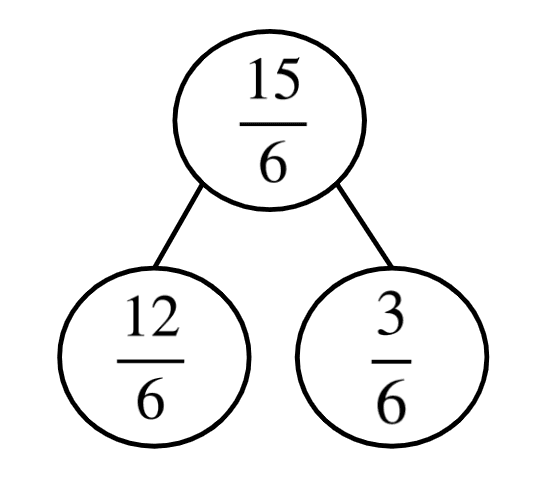Myths about teaching can hold you back


- Year 4
Subtract a proper fraction from a mixed number crossing the whole
I can subtract a proper fraction from a mixed number crossing the whole.


- Year 4
Subtract a proper fraction from a mixed number crossing the whole
I can subtract a proper fraction from a mixed number crossing the whole.
These resources will be removed by end of Summer Term 2025.
Switch to our new teaching resources now - designed by teachers and leading subject experts, and tested in classrooms.
These resources were created for remote use during the pandemic and are not designed for classroom teaching.
Lesson details
Key learning points
- Rods or number lines can be used to support subtracting fractions from whole or mixed numbers.
- Mixed numbers can be expressed as improper fractions to aid subtraction.
- If an answer to a calculation is an improper fraction, this should be expressed as a mixed number.
- Improper fractions can be subtracted in the same way as proper fractions.
Keywords
Mixed number - A mixed number is a whole number and a fraction combined.
Improper fraction - An improper fraction is a fraction where the numerator is greater than or equal to the denominator.
Common misconception
Children may not understand that a one can be exchanged from a whole and the fraction rewritten. E.g. four can be rewritten as three and five-fifths to add subtraction of an amount of fifths.
Use of rods or drawings will support children to understand this exchange. Four is the same as three and one; one is the same as five fifths so four is the same and three and five fifths.
To help you plan your year 4 maths lesson on: Subtract a proper fraction from a mixed number crossing the whole, download all teaching resources for free and adapt to suit your pupils' needs...
To help you plan your year 4 maths lesson on: Subtract a proper fraction from a mixed number crossing the whole, download all teaching resources for free and adapt to suit your pupils' needs.
The starter quiz will activate and check your pupils' prior knowledge, with versions available both with and without answers in PDF format.
We use learning cycles to break down learning into key concepts or ideas linked to the learning outcome. Each learning cycle features explanations with checks for understanding and practice tasks with feedback. All of this is found in our slide decks, ready for you to download and edit. The practice tasks are also available as printable worksheets and some lessons have additional materials with extra material you might need for teaching the lesson.
The assessment exit quiz will test your pupils' understanding of the key learning points.
Our video is a tool for planning, showing how other teachers might teach the lesson, offering helpful tips, modelled explanations and inspiration for your own delivery in the classroom. Plus, you can set it as homework or revision for pupils and keep their learning on track by sharing an online pupil version of this lesson.
Explore more key stage 2 maths lessons from the Efficient strategies for adding and subtracting mixed numbers (crossing a whole) unit, dive into the full primary maths curriculum, or learn more about lesson planning.

Licence
Prior knowledge starter quiz
6 Questions
Q1.Ten one-tenths is equivalent to whole.
Q2.$$ {8} \over {10}$$ - $$ {6} \over {10}$$ =
Q3.Match the expressions to the difference.
$$ {2} \over {4}$$ -
$$ {3} \over {4}$$ − $$ {1} \over {4}$$
$$ {1} \over {4}$$ -
$$ {3} \over {4}$$ − $$ {2} \over {4}$$
$$ {1} \over {5}$$ -
$$ {3} \over {5}$$ − $$ {2} \over {5}$$
$$ {2} \over {5}$$ -
$$ {4} \over {5}$$ − $$ {2} \over {5}$$
$$ {2} \over {8}$$ -
$$ {6} \over {8}$$ − $$ {4} \over {8}$$
Q4.Use the part-part-whole model to express $$ {15} \over {6}$$ as a mixed number.

Q5.Match the improper fractions to their equivalent mixed number.
$$ {9} \over {5}$$ -
$$1{{4} \over {5}}$$
$$ {18} \over {5}$$ -
$$3{{3} \over {5}}$$
$$ {29} \over {5}$$ -
$$5{{4} \over {5}}$$
$$ {34} \over {5}$$ -
$$6{{4} \over {5}}$$
$$ {46} \over {5}$$ -
$$9{{1} \over {5}}$$
Q6.Match the mixed number to their equivalent improper fraction.
$$2{{4} \over {9}}$$ -
$$ {22} \over {9}$$
$$3{{4} \over {5}}$$ -
$$ {19} \over {5}$$
$$1{{6} \over {9}}$$ -
$$ {15} \over {9}$$
$$2{{1} \over {5}}$$ -
$$ {11} \over {5}$$
$$5{{3} \over {9}}$$ -
$$ {48} \over {9}$$
Assessment exit quiz
6 Questions
Q1.Use the number line to calculate 6 − $$ {3} \over {4}$$ =

Q2.Match the expression to its difference.
4 − $$ {3} \over {4}$$ -
$$3{{1} \over {4}}$$
4 − $$ {3} \over {5}$$ -
$$3{{2} \over {5}}$$
4 − $$ {1} \over {5}$$ -
$$3{{4} \over {5}}$$
4 − $$ {2} \over {5}$$ -
$$3{{3} \over {5}}$$
4 − $$ {1} \over {4}$$ -
$$3{{3} \over {4}}$$
Q3.Calculate this. $$5{{1} \over {4}}$$ − $$ {3} \over {4}$$ =
Q4.Match the expression to its difference.
$$2{{4} \over {6}}$$ -
$$3{{1} \over {6}}$$ − $$ {3} \over {6}$$
$$1{{5} \over {6}}$$ -
$$2{{2} \over {6}}$$ − $$ {3} \over {6}$$
$$1{{3} \over {6}}$$ -
$$2{{1} \over {6}}$$ − $$ {4} \over {6}$$
$$3{{5} \over {6}}$$ -
$$4{{3} \over {6}}$$ − $$ {4} \over {6}$$

